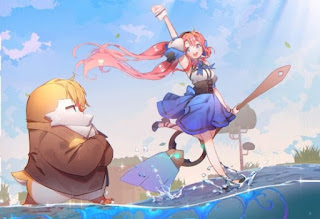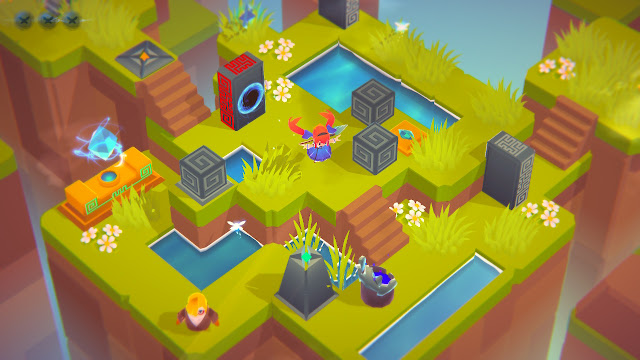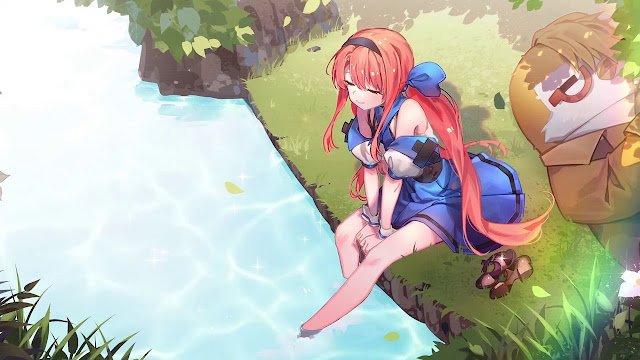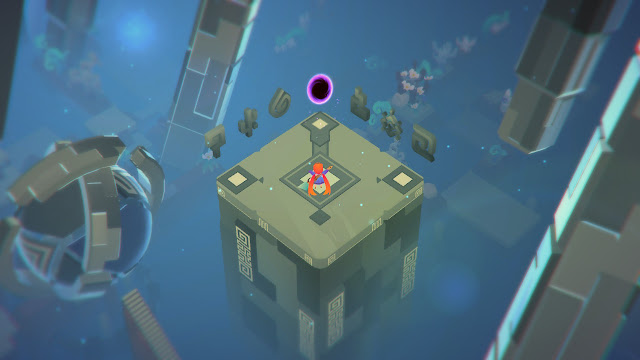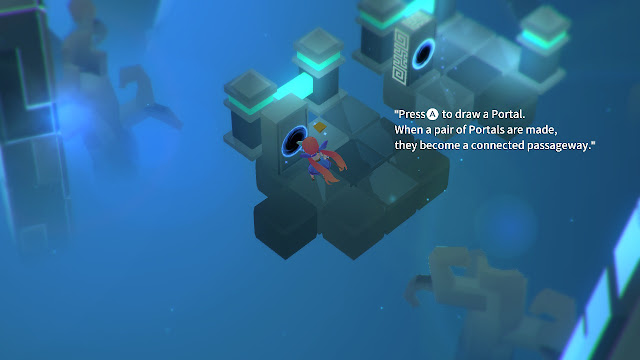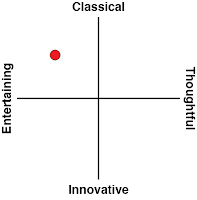Based on QV’s opening and eShop description, you’d be forgiven for expecting an isometric puzzle game with the scope of an epic. They hype up the last member of a chosen lineage and her duty to prevent the collapse of the entire universe. This is technically accurate, sure. However, the emphasis on the story’s launch pad obfuscates what is a more down to earth comedy adventure that kept me engaged until the end.
To be clear, there isn’t much in the way of grand plot revelations to unearth. Character development is discreet. There’s not even a sinister plot or tangible antagonist that needs to be quelled. Against all odds, I found myself craving more instances of QV’s lovable characters simply being themselves.
Protagonist Quby is a carefree, enthusiastic girl who loves stopping to sniff the roses on her quest to stabilise the world. Her brief monologues throughout game’s early levels paint her as an innocent youth who genuinely enjoys her adventure despite the duties associated with her heritage. The scenes depicting Quby’s kindness are simultaneously heart-warming and comedic. Her response to watching penguins clad in punk gear slap each other silly is to chalk their anger up to the humid rain. When interacting with a peculiar talking penguin named Barron however, her devious side surfaces. Her tendency to ignore Barron’s wisdom and make blunt, cheeky remarks at his expense gives the impression she’s wiser than she lets on.
Quby’s personality lends itself perfectly to a character-driven puzzle game. It’s interesting to hear her discuss the environments she’s traversing for the first time. In the snow ruins, Quby takes time to comment on the warmth of a nearby fire and teases her ally about the possibility of cuddling. In the same vein, mundane tutorials and hints are less intrusive when they’re dressed up with a sense of discovery shared between the player and the character they control.
From the player’s perspective, each ruin is clearly freeform and exists to facilitate puzzles with euphoric “eureka” moments. However, there’s actual in-game acknowledgement of the various puzzle-solving tools as pieces of an actual world. To Quby and her friends they’re something to be discovered and contemplated in a human way, silently creating the sense that each level is more than a means to an end. In addition, QV’s brief opening exposition provides an actual in-universe explanation for why the ruins Quby explores might be shaped this way. Was any of this necessary for the core gameplay loop to flourish? Absolutely not, but this simple execution of story to gameplay integration is what I crave from video games.
The game’s story segments are only a handful of sentences in length, but they work wonders in establishing characters for the ensuing light-hearted comedy. Though the English translation is spotty as of this writing, the appeal of the characters shines through at all times. The way the dialogue unfolds while you’re playing might be QV’s greatest underutilised asset. It doesn’t disrupt the game’s flow and you’re still allowed to move Quby freely in some instances. It’s too bad the earlier levels don’t take full advantage of this because you don’t necessarily get that charming commentary in similar games.
In terms of actual gameplay, Quby’s goal to stabilise the collapsing dimensional core plays out by visiting isometric ruins and solving various puzzles. Her pilgrimage spans six linear worlds with five to eight levels each. As you’d expect, these are themed around commonly featured video game environments such as jungles and deserts. Each level opens with a hint at the beginning below the title, but thankfully they’re just little nudges that keep the gratification of problem-solving intact. From there Quby is off to conquer mini-labyrinths with her brains, brawn, and handy brush. Touch a crystal tile, enter a gigantic portal, and move on to the next stage. It’s a basic but effective variation of a proven gameplay formula.
The puzzles follow sound and consistent rules that are introduced naturally. There will be head scratchers from time to time but the game never pulls a fast one by expecting unrealistic leaps in logic. It’s possible you’ll need to restart a stage if you push a block the wrong way, but this is never too dastardly a punishment since the developers accounted for the stage lengths and checkpoint system. Action and timing-based segments rear their heads occasionally but the windows given to succeed are broad enough that almost anyone can complete the game. Despite the trials, the game is relaxing in keeping with the story’s tone.
The key strength of QV’s puzzle design is the interconnected nature of each tool and obstacle. Despite having relatively few of these in play, the possibilities based on their interactions are innumerable. This paves the road for brainteasers that can have longwinded and concise solutions alike. The ability to anticipate multiple moves ahead with precision is rewarded, yet there is value in vigilant experimentation for those who simply want to reach the credits. QV has a greater margin for failure compared to a game like Warlock’s Tower but can also take much longer to solve. The aforementioned checkpoints aid both the investigative player and those who struggle with timing-based puzzles.
To illustrate how QV relies on the relationships between obstacles, it’s best to start with doors. These are large grey slabs that Quby can either erase to pass through freely or paint into dimensional portals. Once portals are activated on two separate doors, they become linked according to color and can then be used to transport Quby and her pals. Typically these doors are important for backtracking in levels that have tiered land.
Besides doors, there are ink buckets used to paint bridges over troublesome surfaces like water and lava. The hitch is that Quby can only carry ink temporarily and the bridges she paints are similarly frail. As bodies of water can be vast and ink bridges only travel in a straight line, figuring out how to design the most efficient bridges can be crucial to reduce return trips to the ink bucket.
If you want to use a door’s portal to smuggle ink to the outer reaches of a level, you need to account for what you’re going to put through a portal in which door at what time. The blocks that can be shoved around are probably the simplest obstacles, but you’ll often need to push them into portals or onto inked surfaces.
As far as tangible danger is concerned, QV’s greatest roadblock is just dodging adorable penguins. That there isn’t any actual combat in this game speaks to Quby’s lovable personality. Since Barron is the only penguin who actually talks, the lack of variety in this area helps reinforce the quaint isolation and discovery. It’s also impressive how much personality went into the penguins. One level features a mechanic where two penguins who see each other will engage in fisticuffs until police penguins talk them down.
Whenever the developers seem as if they’re going to coast on the established mechanics, they find ways to deepen the existing systems. Later down the line, you’ll have control over multiple characters and the ability to switch between them mid-level to deal with specific traps. The interesting part here is that both characters need to reach the goal to win, despite typically starting in different areas of the map. At its best, this multi-character mechanic channels the brilliance of FromSoftware’s unsung The Adventures of Cookie and Cream, albeit slower and more dextrous.
As far as broader design criticisms go, there’s not much to complain about with QV. Most objections will be a matter of preference rather than legitimate oversights. It might have been intriguing to see more world-specific gimmicks such as vines to swing from in the jungle world. I can understand wanting to keep the whole game cohesive, but the world with police penguins cleverly toes the line by adding personality without it becoming an overblown gameplay mechanic. If there’s a QV 2 someday, I hope to see more moments like that in it, especially if Quby has some wholesome or witty comment to drop.
If anything, QV avoids many pitfalls associated with games of its breed. A common complaint about these grid-based character movement games is that once you’ve solved the puzzle there’s little reason to go back. These types of character movement puzzle games tend to have only one or a few possible solutions. I’d contest that assertion right off the bat since if the puzzles are complex and rewarding enough it shouldn’t matter.
Nonetheless, there is replay value for interested parties here in the form of four difficulty levels per stage. Sometimes the difference in design is subtle, other times it makes a straightforward level absolutely mind-bending. There are also three fairies to collect per stage, but they’re often hidden haphazardly. When they’re well concealed or obscured by environmental debris, though, they provide an incentive to interact with obstacles in other ways. I do wish this was the standard since the systems in play present many ways to tinker beyond the scripted solutions.
Although I wasn’t able to test it with the review build of the game, the ability to unlock costumes looks to be a massive boon to QV’s appeal. It taps directly into the game’s pleasing anime aesthetic and uses Quby herself to make each world more vibrant. Binding the character customisation to the achievement system is a choice I can get behind, making the tasks themselves feel less like aimless busywork but a reason to take advantage of the game’s many systems.
As of this writing, QV does have a couple technical issues working against it. The planned patches for the game may well cure these so I’ll keep my points more general. As mentioned earlier, the English translation is not exactly on par with a Clyde Mandelin project. That said, I feel the small studios involved should be cut some slack for providing a whopping seven language options despite the numerous challenges that entails. If the speech in the game’s screenshots and trailers puts you off, I urge you to give the game a chance anyway since very little appears to be lost in translation.
Another issue I’m unsure will be addressed was self-inflicted on my end but is still worth mentioning. Grabbing a checkpoint at the wrong time can lock you into an infinite failure sequence if you’re running from penguins and happen to get cornered. This is because the game saves the exact state of the world as you touch it, so you’re stuck unless you restart the level. Again, considering this game was made by only a handful of people and is plenty functional as a whole, I’m hardly throwing a tantrum. I’m mainly bringing this up in passing because, armed with this knowledge, you can hopefully avoid the issue altogether.
QV is another puzzle-shaped feather in the eShop’s cap. Its brainteasers successfully balance accessibility with sophistication. Its vibrant art style and subdued soundtrack evoke pensiveness. However, it’s the small cast of characters and playful comedy that truly solidify it as exceptional. I wish the developers doubled down on these low-key moments since they breathe new life and context into the underlying puzzle game. Even so, QV is an adventure I won’t soon forget.
– Clark A.

